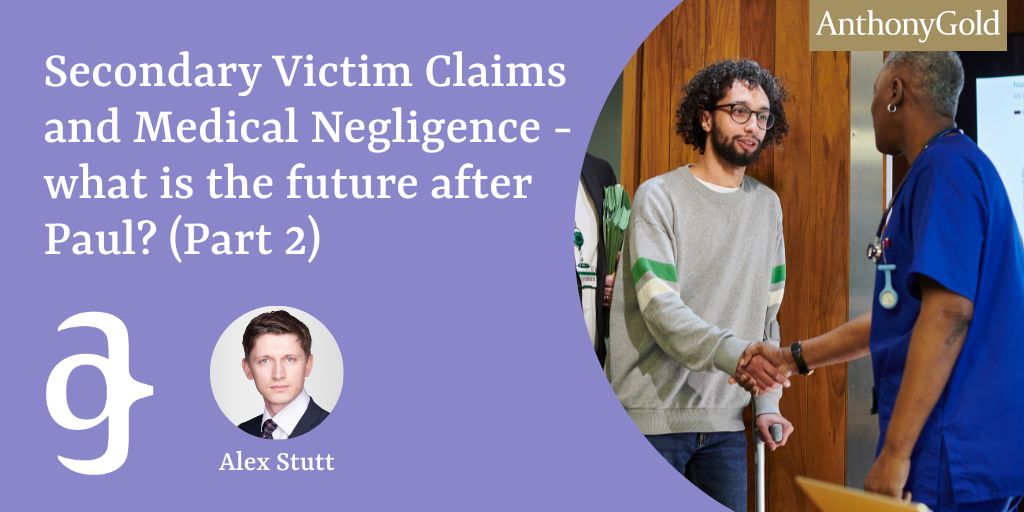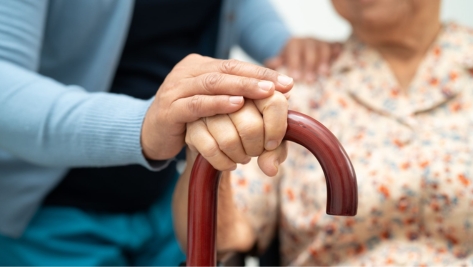Secondary victim claims and medical negligence – what is the future after Paul? (Part 2)


This post is the second in a two-parter covering the landmark Supreme Court case of Paul and another (Appelants) v Royal Wolverhampton NHS Trust (Respondent) (2024) (referred to as “Paul” in this post). As discussed in part one, the need for a Paul “accident” raises particular issues for secondary victim claims arising from medical negligence. However, do the court’s comments on duty of care in Paul make such claims even harder?
Secondary victims are those who have suffered psychological injury from perceiving injury or the risk of injury to a loved one, who is known as the primary victim.
The requirements to succeed in a secondary victim claim are not easily met. Public policy considerations about opening the floodgates to such claims have mitigated against previous attempts to extend the law, arguably at the expense of victims of catastrophic psychological injury. Notably in the case of Alcock v Chief Constable of South Yorkshire (1991) the House of Lords found that loved ones of people killed and injured in the 1989 Hillsborough Disaster were unable to claim for psychological injury caused by witnessing the tragedy unfold on television.
Notwithstanding the court’s tight controls on these types of claims, prior to Paul the case law did not appear to discriminate based on the setting or context in which the primary victim was injured. I have summarised the court’s current criteria for such claims to succeed below, indicating in bold the changes recently arising from Paul. You will note that these criteria appear to apply equally to primary victims injured in road traffic accidents, accidents at work, public places, and in medical settings.
- The harm (or risk of harm) to the primary victim must have been caused by an accident, which is an unexpected and unintended event which causes injury (or a risk of injury) by violent external means.
- The claimant must have been in close proximity to the accident or its immediate aftermath (in time and space).
- The psychiatric injury must be caused to the secondary victim by them seeing or hearing the relevant accident or its immediate aftermath through their own unaided senses.
- There must be a recognised psychiatric injury suffered.
- It must be reasonably foreseeable that a person of “normal fortitude” or “ordinary phlegm” might suffer psychiatric injury.
- There must have been a close tie of love and affection between the secondary victim and the primary victim.
The court’s comments on medical practitioners’ duty of care
The Supreme Court found against all the claimants in Paul on the basis that each claim arose from a “medical crisis” rather than an “accident”. Although that alone was sufficient to defeat the claims, the Supreme Court nevertheless went on to consider the scope of a medical professional’s duty of care and whether this could extend to a patient’s loved ones.
Lord Leggatt and Lady Rose prepared the leading judgement. In their analysis they considered the particular qualities of the doctor-patient relationship, and the factual questions that arise about determining the extent of control that a doctor may have over risk of injury to a patient’s family members. They concluded as follows (paragraph 138):
“We are not able to accept that the responsibilities of a medical practitioner, and the purposes for which care is provided, extend to protecting members of the patient’s close family from exposure to the traumatic experience of witnessing the death or manifestation of disease or injury in their relative. To impose such a responsibility on hospitals and doctors would go beyond what, in the current state of our society, is reasonably regarded as the nature and scope of their role.”
Comment
Are the court’s comments an outright block to secondary victims in a medical negligence setting in future? This author would submit probably not, although they do raise additional hurdles to such claims succeeding.
Should defendants seek to argue that a patient’s loved ones are, following this judgement, outside the duty of care of that patient’s doctors, it should be pointed out that the court’s comments were made in the context of each of the family members in Paul witnessing either a “medical crisis” or a “manifestation of disease or injury” (specifically a heart attack, pulmonary veno-occlusive disease and severe pneumonia), rather than an “accident”. Therefore, they should be read as the court emphasising the necessity for an “accident” in a successful secondary victim claim, rather than ruling out such a claim in a medical setting after an “accident” has occurred.
Furthermore, the court’s cultural and political objections to extending a doctor’s duty of care to a patient’s loved ones do not apply so easily in “accident” based cases. As indicated above, the Supreme Court took the view it would be wrong to expect doctors to protect their patients’ family members from the psychological effects of death and (to a lesser extent) medical problems, when these were an unfortunate but inevitable parts of life. However, an “accident” is by the court’s own definition an unexpected and violent means of suffering an injury. By contrast with a medical deterioration, it is not the sort of event anyone expects to witness, even in a medical setting. Therefore, it would be would be surprising for the court to maintain that there would be anything societally inappropriate about holding a doctor liable for psychological harm caused by a negligent “accident”, just as any other profession would be found liable in those same circumstances. This is particularly true in cases where doctors have not merely failed to protect against harm, but have actually caused their patients direct harm through negligence (for example, where a clinician has burnt or dropped a heavy item on a patient, or where a surgeon has amputated an incorrect limb).
As far as this author is aware, no secondary victim claims arising from medical negligence have reached the courts since Paul. It will undoubtedly be difficult for future such claims to succeed, but equally it would be wrong to assume that they are bound to fail. One thing is certain; there is now an additional onus on medical negligence practitioners to think creatively about how to present such claims in light of the additional hurdles posed by Paul.
Please note
The information on the Anthony Gold website is for general information only and reflects the position at the date of publication. It does not constitute legal advice and should not be treated as such. It is provided without any representations or warranties, expressed or implied.
Related Insights
- January 19, 2024
Secondary Victim Claims and Medical Negligence – what is the future after Paul? (Part 1)
- March 2, 2020
Non-delegable duty and vicarious liability in the healthcare sector
- June 23, 2020
Secondary victim claims: Paul v Royal Wolverhampton NHST
- September 22, 2023
Fixed Recoverable Costs, Clinical Negligence and Access to Justice – an Update
- August 8, 2023
Compensation Obtained Following Glaring Surgical Error
Our Latest Injury & Medical Claims Insights
- October 6, 2025
Jess’s Rule – a welcome reminder to reconsider persistent symptoms
- September 26, 2025
Intermediate track injury claims: the rise of early settlement offers
- August 26, 2025
Anthony Gold Solicitors welcome Helen Whittam as a new Support and Rehabilitation Coordinator in the Injury and Medical Claims Team
- August 19, 2025
Contributory negligence and children
- August 13, 2025
Video: From tragedy to triumph – Eliezer’s journey after a life-changing accident
- July 9, 2025
What is Contributory Negligence and How Could it Affect Your Claim?
Related Guides
- April 29, 2025
Understanding The Essentials Of A Clinical Negligence Claim
Latest Articles
View allGuide: October 9, 2025
Guide: October 8, 2025
Contact the Conveyancing team today
Contact us today
"*" indicates required fields
Contact the commercial
& civil Dispute team today
"*" indicates required fields
Contact the Conveyancing team today
Contact the Conveyancing team today
Contact the Wills, Trusts
& Estates team today
Contact the Court of
Protection team today
Contact the Employment Law team today
Contact the Clinical Negligence team today
Contact the Family & Relationships team today
Contact the Personal Injury Claims team today
Contact the leasehold & Freehold team today
Contact the Corporate & Commercial team today
Contact the housing & disputes team
"*" indicates required fields















